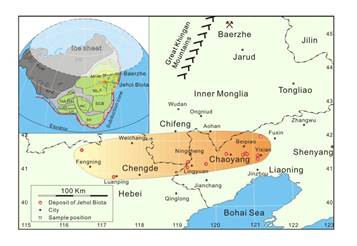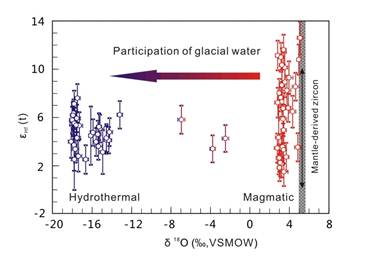Cretaceous is one of the hottest periods in the Earth’s history, called “super-greenhouse”. Dr. Wubin Yang from Guangzhou Institute of Geochemistry, Chinese Academy of China (GIGCAS), and his co-authors recently found that extremely 18O-depleted signature was recorded in the Early Cretaceous zircon, induced by incorporation of glacial meltwater. This record is consistent with previously documented global sea-level fall and dramatically negative shift of carbon isotope of Pacific sediments, indicated that the occurrence of cold interval in the supergreenhouse era, and even that large continent ice-sheet would be existed in mid-latitude region.
Zircon is the main economic mineral in the Baerzhe giant Zr-REE-Nb deposit, on which systematic analyses were carried, including in-situ composition determination, O-Hf isotopes analyses and SIMS U-Pb dating. The hydrothermal zircon, formed in late stage of magmatisim, is characterized by extremely low δ18O values, ranging from -18.12‰ to -13.19‰, which were induced by the participation of highly evolved surface water. Considering the paleolatitude and paleoaltitude of the region, continental glaciation is suggested to occur in the early Aptian (ca. 124 Ma), indicating that much larger temperature fluctuations than previously thought would be occurred during the supergreenhouse Cretaceous. More broadly, this may have impact on the evolution of major organism in the Jehol Group during this period, including the absence thermophilic reptiles such as crocodilians and the occurrence of gigantic feathered theropod dinosaur.
This project is conducted by the research teams of Prof. Hecai Niu and Prof. Weidong Sun from GIGCAS, co-authored with Academician Yongfei Zheng, Prof. Xing Xu and Prof. Nicholas T. Arndt. Relative article was published at September 24 in Scientific Reports of Nature Publishing Group.
Article hyperlinks: http://www.nature.com/srep/2013/130924/srep02732/full/srep02732.html
ABSTRACT:
Cretaceous represents one of the hottest greenhouse periods in the Earth’s history, but some recent studies suggest that small ice caps might be present in non-polar regions during certain periods in the Early Cretaceous. Here we report extremely negative δ18O values of -18.12% to -13.19% for early Aptian hydrothermal zircon from an A-type granite at Baerzhe in northeastern China. Given that A-type granite is anhydrous and that magmatic zircon of the Baerzhe granite has δ18O value close to mantle values, the extremely negative δ18O values for hydrothermal zircon are attributed to addition of meteoric water with extremely low δ18O, mostly likely transported by glaciers. Considering the paleoaltitude of the region, continental glaciation is suggested to occur in the early Aptian, indicating much larger temperature fluctuations than previously thought during the supergreenhouse Cretaceous. This may have impact on the evolution of major organism in the Jehol Group during this period.

Figure 1 | Geographical positions of the Baerzhe intrusion and the deposits of Jehol Biota.

Figure 2 | Plot of εHf(t) versus δ18O values for magmatic and hydrothermal zircon in this study, showing remarkable shifts of oxygen isotopes corresponding to incorporation of continental glacial meltwater into the alkaline magma.
GIGCAS Science and Technology Department
& CAS Key Laboratory of Mineralogy and Metallogeny

